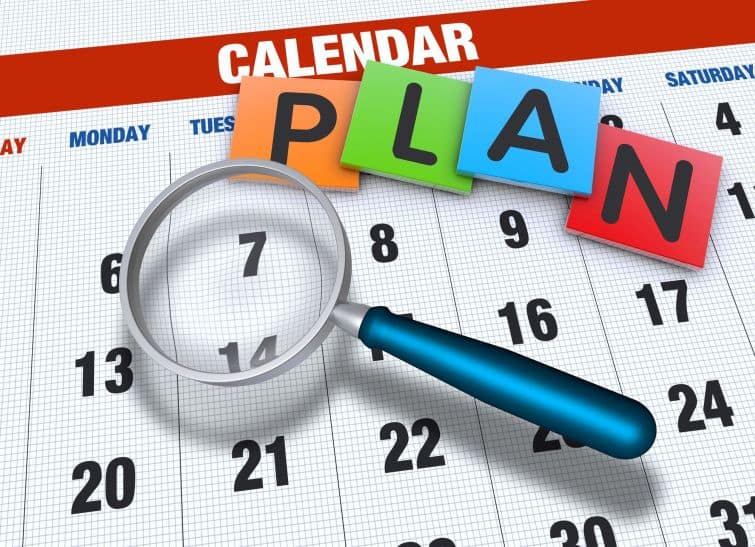Have you struggled with your schedules? Do you have challenges in scheduling your day? You get started on scheduling on a whole day and then it just gets overwhelming, and you get stuck? Or maybe you’re OK with making the schedules, but it’s just sticking to them. You start by making progress on these little tasks. But then something happens, you fall off track and you just can’t recover.
In the Personal Retreat, I provided a wealth of information on finding the most important areas of your life to improve and creating goals that can address those areas. What I have today are the tools to ensure completion of those tasks which help you achieve your goals. A schedule. Now, before we start, I want you to bear with me, because as we learn this process, I’m going to ask you to schedule everything.
This can be your lunches, your tasks, your breaks; we’re going to fill that calendar up! As you get used to using a schedule, you can then focus a little bit more on scheduling the important tasks rather than every little thing. It can be a comfort to do that because you always know what you’re up to and you can help avoid being becoming overcommitted.
Time Blocking
I’m going to show you some ways to do time blocking. Time blocking might be something familiar to you already, but I have made some slight changes which might make it easier.
To get started, you’re going to need a scheduling tool. Now, some people like to use an online calendar like Google or Apple Calendar. When it is electronic, it is easy to access. If you have a smartphone app, the calendar is very accessible. Those are those are excellent tools.
You may be the type that needs to use pen and paper. It can still be very effective, and I do have a couple tips for you. If you do choose a pen and paper route, there’s a book called Bullet Journal which talks about how to use bullet pointed lists for your daily to do list.
That can be a huge value to you. And of course, you can just use a straight up plain old list instead of a calendar. But if you do so, I want you to pay attention to that time block. Make sure that you are working with the right amount of time in the day dedicated to these tasks. Time blocking is all about choosing a block of time, of a manageable size that you can focus on and commit to doing a task.
Now you pick a time block size that you’ll use for your goals or your tasks. It might be really helpful to just start with one hour. One hour is enough time to get focused and accomplish something. You can change this the size of this time block later if you find that you regularly have shorter or longer tasks.
Begin with Fixed Items
Now we get started with scheduling. We’re going to schedule a week at a time, just for starters. So, the first thing we want to do is schedule the things that are fixed. These are the tasks you can’t really change and you must do regularly. What’s the number one of these will sleep? Of course, we must sleep. We need to set that time aside first. How much time do you need to set aside? Well, everyone’s a little bit different. Either choose an amount of time or work backwards from the time that you need to be awake. Try to make this scheduled sleep time consistent seven days a week. It’s proven that a consistent seven day a week sleep time is great for your health.
Next fixed item is your work. If you have a fixed work schedule, this is the next best thing to add in. Don’t forget to include time for your commute and lunch breaks. Any other tasks that you have that are fixed commitments can now go in. You’ll want to enter those like you might have some volunteer meetings, family or business obligations that need to go in. Now we get to schedule our most important tasks.
Scheduling Tasks & Habits
You may have tasks that are around exercise. So where can you fit in that one-hour time block that you’re going to be working out? This might be for a fitness or weight loss goal. Another is education. Where can you put in the time that you’re going to work on your lessons? This could be for some educational goal that you have for yourself. Be sure to add in a goal, check ins and calendar updates. You want to make sure that you keep this process going.
Last, make sure you add tasks that are otherwise directly related to your goals, like phone calls, making appointments or doing research time.
Scheduling Tips
Next, some tips on scheduling. Make sure to overestimate the time that you need to complete a particular goal. Rounding up to the hour can give some benefits. It’s easier to move that block around in case you have to reschedule it. And it’s always better to have just a little extra free time. You might want to be aware of the times of day that you were better at doing some tasks than others. Some people find, for example, are more productive in the morning.
You may find that doing your workout in the morning should be changed to the evening or vice versa. Ask yourself this. Where are you going to feel up to doing the tasks that you scheduled after the thing that it is that just comes before? So, for example, if you do your workout and then you plan to go grocery shopping, is that going to be the best fit for you? I know that for myself, I’m going to overbuy at the grocery store if I just worked out and I’m hungry, so maybe I’m going to switch those around.
Using Your Schedule
Now for using your schedule, I have some keys that will help you commit to making your schedule work for you. Number one, keep making changes to the process until it works well for you. That means changing your time block sizes in case it gets too big or too in case you just keep running out of time.
Make sure to pay attention to when you do things like exercise or running errands, as in the example I gave before. Pick the best time that you’re the most productive for the task.
The next tip is that makes it easier to commit is to schedule things that you enjoy. Scheduling time for family or TV time is something to look forward to. Maybe taking yourself out to lunch or dinner as a treat. These can be good things to help you keep with doing your schedule. Also, for number three, be willing to start your next task early if you get done ahead of time. And there’s some great benefits to this personally, there’s nothing more inspiring to get several hours of work accomplished in much less time than I had set aside for.
I also really get excited to work on the next day’s tasks if I get things done that are right in front of me. And this allows you to adjust for more downtime or for getting more done. Either way, it’s a win. If you start to feel overwhelmed, make adjustments. Be willing to take small breaks in between your tasks. And if your tasks are consistently taking longer than that one hour, then setting a new longer standard time block is in order. Use an hour and a half, maybe two hours.
Please contact me if you have questions about these tips or you’d like to share what tips that you might have that you’ve used to manage your schedule.


